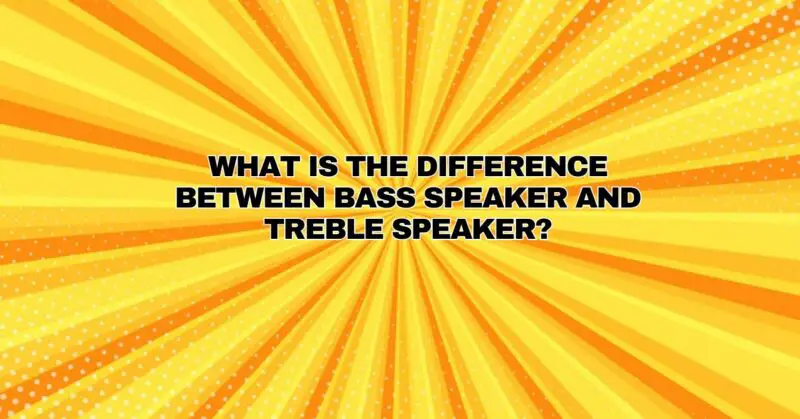In the world of audio, the terms “bass” and “treble” are often used to describe two fundamental components of sound. These components are reproduced and conveyed to our ears through specialized speakers known as bass speakers and treble speakers. In this comprehensive article, we will delve into the differences between bass and treble speakers, their unique characteristics, and their roles in shaping the overall sound experience.
Bass Speakers
1. Frequency Range: Bass speakers, also commonly referred to as woofers, are designed to reproduce the lower frequencies of sound. This typically includes frequencies in the range of 20 Hz to 500 Hz or even higher. These lower frequencies provide the foundation for the audio spectrum, delivering the thumping beats of a drum, the rumble of a bass guitar, and the resonance of a deep voice.
2. Driver Size: Bass speakers feature larger driver cones compared to treble speakers. The increased size allows them to move more air, which is essential for generating the lower frequencies associated with bass. These larger cones are capable of displacing greater volumes of air to create the physical impact and sensation of bass.
3. Enclosure Design: Bass speakers are often housed in enclosures designed to enhance bass response. Common enclosure types for bass speakers include sealed enclosures, ported (bass reflex) enclosures, and passive radiator enclosures. Each design has its unique characteristics, affecting bass reproduction and efficiency.
4. Bass Management: In multi-driver speaker systems, bass speakers handle the low-frequency portion of the audio spectrum, while other drivers (such as midrange and tweeters) focus on higher frequencies. Crossover networks are used to direct specific frequency ranges to the appropriate drivers, ensuring that bass speakers handle only the frequencies within their range.
Treble Speakers
1. Frequency Range: Treble speakers, often referred to as tweeters, are specialized in reproducing the higher frequencies of sound. They typically cover the frequency range from around 2,000 Hz (2 kHz) to 20,000 Hz (20 kHz) and beyond. These frequencies encompass the delicate shimmer of cymbals, the clarity of vocal sibilance, and the intricacies of high-pitched instruments like violins.
2. Driver Size: Treble speakers feature smaller driver cones or diaphragms compared to bass speakers. These smaller diaphragms are capable of rapid and precise movements, which are essential for accurately reproducing high-frequency sounds.
3. Enclosure Design: Treble speakers are often incorporated into speaker systems with dedicated enclosures. These enclosures may be sealed to prevent unwanted interference with the bass frequencies or ported to enhance treble response, depending on the speaker’s design goals.
4. Treble Clarity: The primary objective of treble speakers is to provide clarity and detail in the higher-frequency ranges. Their design prioritizes precision in sound reproduction, allowing listeners to discern subtle nuances and high-frequency intricacies within the audio content.
Conclusion
Bass speakers and treble speakers are fundamental components of audio systems, each specializing in distinct portions of the frequency spectrum. Bass speakers, or woofers, excel at reproducing deep, low-frequency sounds, providing the foundation and impact in music and audio. Treble speakers, or tweeters, focus on the higher frequencies, delivering clarity, detail, and precision to the listening experience.
In a well-designed audio system, these two types of speakers work in harmony, complementing each other to reproduce the full range of frequencies present in audio content. Understanding the differences between bass and treble speakers allows audio enthusiasts and professionals to create balanced sound systems that deliver a rich, immersive, and detailed listening experience across the entire frequency spectrum.


